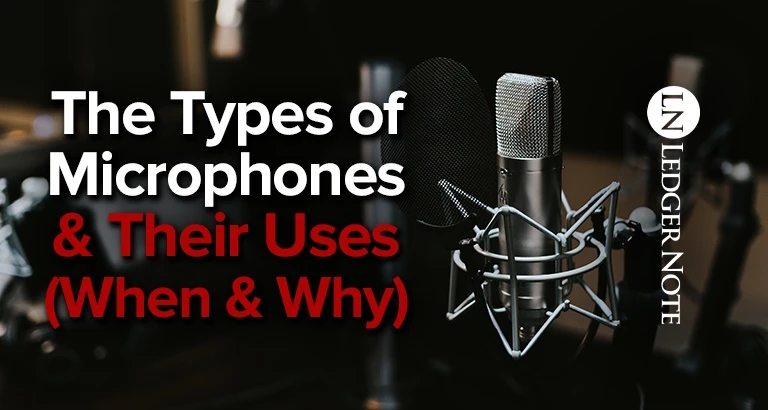
In most cases most people will only ever deal with three types of microphones. These are the main choices used in most recording and broadcasting scenarios.
The main difference is in their diaphragms, which is the mechanism that reacts to sound and converts it to an electrical signal that can then be sent out of a speaker or recorded onto magnetic tape or a computer’s memory.
Due to the variation in the construction of the diaphragms, each of these three main types has different levels of sensitivity as well as tonal characteristics. I’ll explain how each one performs below. If you know these three mic types, then you know enough to make the right decisions for your needs.
Beyond that, I’ll show you some other microphone types that you may hear about or see, but possibly never encounter a need to actually use them yourself. And they’re all just sub-types of the main three with different pickup patterns, so you won’t get confused at all.
The 8 Types of Microphones
The most important categories of mics to think about and remember are the following three:
- Condenser Mics
- Dynamic Mics
- Ribbon Mics
Those three categories, based on the type of diaphragm used, cover the broad range encompassing all of the other sub-categories. It’s still useful to mention some other types that fit in these main categories but have such unique applications that we discuss them as being separate. Those are:
- Multi-Pattern Mics
- Bass Mics
- Shotgun Mics
- Boundary Mics
- USB Mics
There are others you’ll encounter, such as lapel mics (like TV hosts wear clipped to their jackets), but for the most part the above types are the ones you’ll hear about. Some people break them down further and there’s always edge cases. But this is more than good enough.
The 3 Main Microphone Types
If you remember anything from this article, this is what you want to remember. There are three main types to remember: condenser, dynamic, and ribbon.
Let’s look at each individually so you can understand why they exist and when to choose them.
Condenser Microphones

Use When: in the studio with low noise, recording vocals, recording guitar and other high frequency instruments, needing to capture subtle details, the sound source isn’t extremely loud.
There are two sub-types of condenser mics, which are large diaphragm condenser mics and small diaphragm condenser mics. It’s obvious what the difference is based on their name. Each shines in a different application, which I’ll mention below.
Condenser mics are typically chosen for studio recording when you’re in a controlled environment with no noise and great acoustics, meaning sound won’t be bouncing around off of the walls and back into the mics.
The reason they’re chosen is because they’re extremely sensitive and can pick up a ton of detail other types can’t. That’s why you wan’t a perfect acoustic environment, because they’ll record unwanted noises too.
They’re also chosen mainly for vocals and instruments like acoustic guitar, violin, and anything that doesn’t produce a signal that’s too loud and has subtleties that need to be captured. You can damage the diaphragms if you subject them to too much sound pressure levels (SPL).
Large diaphragm condenser mics are the best choice for vocals while small diaphragm condensers (often called pencil microphones due to their shape) are great for instruments with a lot of detail in the high frequencies, like the aforementioned guitar or violin.
You can stick to large diaphragm options only and do just fine, though, which is what I choose to do in order to keep my mic cabinet smaller and more organized. We’ve previously covered our top picks for the best condenser microphones in several budget ranges if you want to get an idea of what’s out there.
Two more interesting things about condenser mics is they contain vacuum tubes that can be switched out to provide various amounts of warmth and saturation, and they require 48 volts of phantom power to power their active electronics. Our article What is Phantom Power? explains more if you’re interested.
Some can take a battery or have their own power supply, but most of the time a microphone preamplifier (which all microphones must be coupled with) have the ability to send phantom power up the mic cable to power them.
Dynamic Microphones
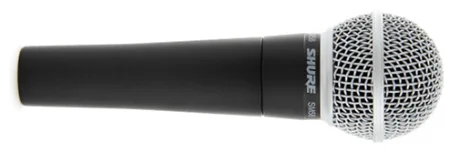
Use When: on stage or any live or noisy situation, recording guitar amplifiers, on loud sound signals, on signals that vary in volume, recording rap and rock vocals.
Typically when you want to record an instrument or vocalist with either a wider range in amplitude (volume) or that is very loud, you’ll opt for a dynamic mic. They can handle higher SPL’s without sustaining damage or producing internal distortion.
Because they’re less sensitive, they’re often a better choice for live situations when there’s an audience like a press conference, music concert, or a news interview out in the field. They’ll pick up less unwanted ambient noise.
Even in the studio these are the right choice for recording a guitar amplifier, drums, or loud vocals like those from a heavy metal or rock singer. Many rappers are recorded with dynamics as well, partially for their proximity effect which is a bass boost when the mic is very close to the instrument or mouth.
We’ve previously covered our favorite picks for the best dynamic microphones in various budget ranges, if you’re interested in seeing a wide range of options in this category. These are a must have for any music studio, as are condensers.
Dynamic mics contain passive electronics and don’t require phantom power. You won’t hurt them by accidentally feeding them this power, as you’ll often hear. But you can definitely hurt the next type if you do that.
Ribbon Microphones

Use When: in the studio seeking a warm and vintage sound. These are rare, fragile, and expensive. Opt for a condenser mic instead.
The last of the three main types is the ribbon mic. All other mic types are either condenser or dynamic, but the ribbon mic is a category of its own due to the unique diaphragm it uses. I’m sure you’ll be surprised to hear that it’s in the shape of a long, thin ribbon.
These were some of the earliest mics available and are making a comeback but are still rare. We loved them because they could offer even more detail than condenser mics, but the problem was they were very fragile. Any damage to the flimsy ribbon would ruin them, and they were extremely expensive and still are.
Even to this day, a mistake like running 48v of phantom power to them could fry the ribbon. Dropping them can break the ribbon. There’s really no point in using one of these in the present age due to equally good and far more durable options.
The 5 Other Types of Mics
Let me say again, these are all either condenser or dynamic mics, but they get their own category for their unique design purposes. They are built for a specific reason and thus are thought of as their own sub-categories although that’s not perfectly accurate.
If you’re interested in the topic of mics, please read on because these special sub-types give cause to explain other things you need to know about, like pickup patterns, preamplifiers, and more.
Multi-Pattern Microphones
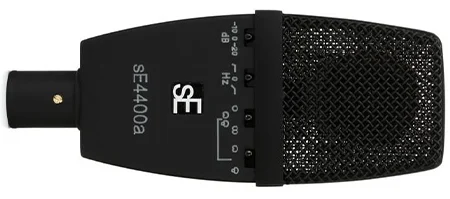
Use When: wanting to record ambient sounds in the environment, groups of vocalists or a bluegrass group, vocal duets or harmonies. Most of the time you’re better off with a condenser and cardioid pickup pattern.
You may not know this yet, but nearly every microphone uses the cardioid pickup pattern (sometimes called directionality). The cardioid pattern basically records everything in front of it and to the sides while rejecting sound coming from behind.
Obviously this is the most useful pickup pattern, especially since we tend to record everything on it’s own track for mixing purposes later. But there are many other pickup patterns that you may want to use, and that’s where multi-pattern mics come in.
These have switches on them letting you select different pickup patterns. These include patterns like supercardioid, hypercardioid, figure-8, shotgun, and omnidirectional. Essentially, they give you choices to record in front and behind, all around in 360 degrees, or in a tight laser focus pattern.
For the most part, you’ll never use these. Omnidirectional is good for recording ambient sounds for TV and film while shotgun mics are good for recording people’s voices for the same purpose.
Figure-8 patterns can sometimes work for stereo recording though I can’t imagine a scenario where I wouldn’t want two mono tracks instead. Plus they aren’t aim-able. You get two sides and that’s it, which is far less useful than using two separate cardioid pattern mics.
Bass Microphones
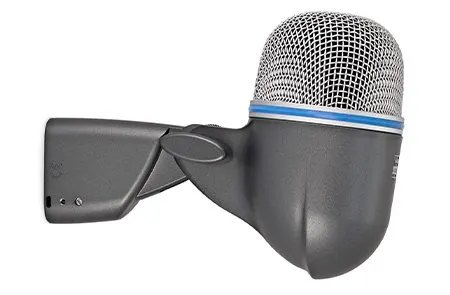
Use When: recording kick drum, bass guitar cabinets, cello, or any deep frequency sounds or musical instruments. Not for bass vocals.
Bass mics are designed with one key purpose in mind, which is to record instruments that are extremely deep in the frequency spectrum. This would include a bass guitar, kick drum, cello, etc. You’ll often see them labeled as kick drum mics, but that’s just one application.
What makes them unique is their frequency response. Their designed to record nuance in the bass region but also have a low end boost plus a scoop in the mids. This scoop in the mid frequencies is good because bass instruments often sound muddy or boomy in most small rooms.
Shotgun Microphones
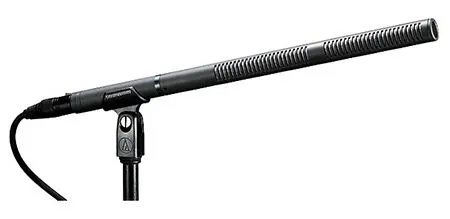
Use When: recording actors on set for film or television, recording sound effects in the field, attempting to record any specific source from a distance.
Shotgun mics have two key characteristics. They’re small diaphragm condensers that have the shotgun pickup pattern, meaning they reject as much sound as possible from all directions except the tightly focused area you aim it at.
In addition, they usually have a very long interference tube at the front that filters even more sound from the sides. They look like shotgun barrels and that’s how they got their name. The reason this tube exists is because the pickup pattern still accepts sound noise from the sides (there’s no way around it).
So the best we can do is hide the diaphragm deep behind this acoustic shield tube. It works amazingly well and produces the vocal recordings you hear on nearly all TV shows and movies you watch. You’ll have seen people on set holding these long, fuzzy mics over the top of the scene at some point or another.
Boundary Microphones
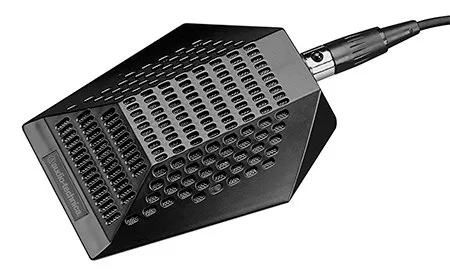
Use When: recording entire rooms like a conference room, theater stage performance, church choir, a room mic in the studio, etc.
Boundary mics are an anomaly that exist for two specific reasons. They don’t suffer from comb filtering because they’re right up against the walls that reflect sound and cause the comb filtering. The other reason is to record the sounds of an entire room out of convenience.
Typically, you’ll find these in business conference rooms at the center of the table everyone is seated at and sometimes in theater auditoriums laid on the front of the stage to record the performance. Otherwise, you’ll sometimes (rarely) find them in studios being used as room mics to give more options during mixing.
USB Microphones
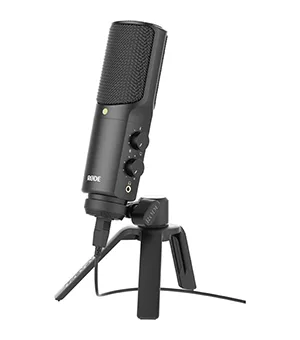
Use When: recording hobbyist levels of music, podcasts, audiobooks, YouTube videos, etc. Useful to quickly record music demos or ideas at home. Don’t expect superb quality.
The last of the different types of microphones is the USB mic. When these first came out in the mid 2000’s, everyone including me scoffed at them. They flat out sucked, but that’s because they were being made cheaply to see if people even wanted them. Turned out they did and the quality has gotten better.
These exist solely for people who do hobbyist levels of music recording, podcasting, or narrating audiobooks. They contain tiny preamplifiers and analog-to-digital converters in them, and then spit the digital signal out of a USB cable so your computer can capture the recording.
It’s an extremely cheap way to get into recording, but you’ll be guaranteed sub-par quality. It allows you to skip buying a separate mic preamp and an audio interface, which would have been of a much higher quality. You’re trading convenience and cost for quality, which may be fine for your needs.
I feel I should mention microphone preamplifiers, which all mics need unless it’s a USB mic (which also needs them but contains one). Microphone audio signals come out at a very low amplitude and have to be boosted up.
If you try this with the volume knob you’ll be turning up a ton of background noise too. Preamps are designed to boost the signal without also boosting the noise floor. Not only can you not record anything of decent quality without one, they’re probably the most important piece of equipment if you want professional quality, even more so than the microphone itself.
And That’s the 8 Mic Types!
To reiterate, if all you remember is that condenser and dynamic microphones exist and for what purposes, you know enough to make the right choices about when to use them. Ribbon mics are the 3rd main type but are so rare that you can forget about them.
The other types of microphones are really just sub-categories but are talked about separately due to being created for specific purposes. They’re pretty self-explanatory by their names, so don’t stress about it. You’ll remember what they’re for when you hear their names. Have fun out there, and happy recording!